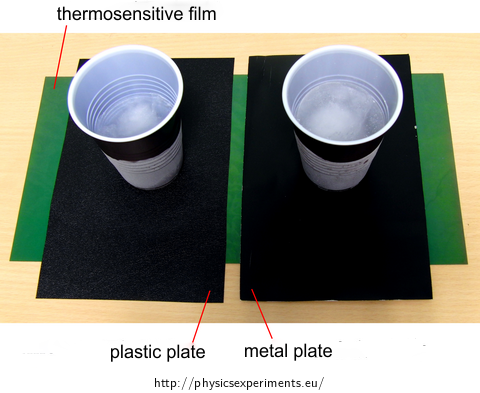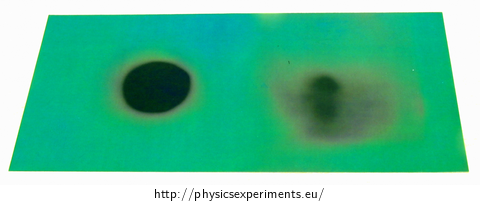Thermal Conductivity of Plastic and Metal II.
Experiment number : 1939
Goal of experiment
In this experiment, we visualize the cooling of metal and plastic plate; the goal is to highlight the different thermal conductivity of these materials.
Theory
See the section Theory of an already described experiment Thermal Conductivity of Plastic and Metal I., Theory.
Tools
A thermal imaging camera, a metal plate and a plastic plate of approximately the same size, two cups with ice
Procedure
We place one cup on each plate simultaneously and observe them with the thermal imaging camera for about 100 seconds. Whereas the metal plate is cooled down almost evenly during this time, the temperature of the plastic plate decreases only at the points of contact with the cup. Plastic – being a heat insulator – does not allow the cooler area to be reheated by heat supplied from its surroundings.
Sample result
A successfully performed experiment is illustrated by the video below. The metal plate is always to the right, the plastic plate to the left.
A thermal imaging camera FLIR i7 was used when making this video. The temperature range of the colour scheme was chosen in the interval 16 °C to 22 °C, the emissivity was ε = 0.95.
Technical notes
See Technical notes listed in the experiment Thermal Conductivity of Plastic and Metal I.
Pedagogical notes
We must be careful when interpreting this experiment. Our visualization can lead to the conclusion that something like “cold” can distribute through matter the same way heat does. We should be aware that, without sufficient explanation, we can strengthen the misconception in students that heat and “cold” are two independent phenomena, which helps in explaining certain occurrences in some situations.That is why we should stress out that in the case of the metal plate it is not “cold spreading from the cup”, but “heat absorbed by the cup”.
How to perform the experiment without thermal imaging camera
A thermal imaging camera is a very expensive device, but the experiment can be performed using a much more affordable thermosensitive film, which can be found under the name reversible temperature label. Place the thermosensitive film under the plastic and metal plate (see Fig. 1). This way it is not necessary to coat the shiny surfaces by a matte coating.

In this experiment, the thermosensitive film operating in the temperature range from 20 °C to 25 °C was used. At room temperature (about 22 °C), the film is light green; during cooling, the colour changes from green to brown to black. The result of the experiment using thermosensitive film is shown in Fig. 2 (the metal plate is to the right, the plastic to left).

Theory specification – thermal diffusivity
If we want to be fully accurate, the distribution of heat is described not by thermal conductivity, but by thermal diffusivity α, [α] = m2·s−1. This quantity combines thermal conductivity λ, specific heat capacity c and density ρ with the following formula:
\[\alpha\,=\,\frac{\lambda}{c\varrho}\]The greater the value of thermal diffusivity, the better a homogenous substance is at evening out temperature differences in its volume during continuous conduction of heat. The table below shows the thermal diffusivity of some substances (at the temperature of 20 °C); there is little point in talking about thermal diffusivity in fluids, because heat in them is mainly transferred by convection.
material α/m2·s−1 copper 11.3·10−5 aluminium 9.8·10−5 brass 3.7·10−5 iron 2.3·10−5 glass 3,4·10−7 styrofoam 9.2·10−8 It is apparent that there are differences in several orders between the thermal diffusivity of metals and plastics.







